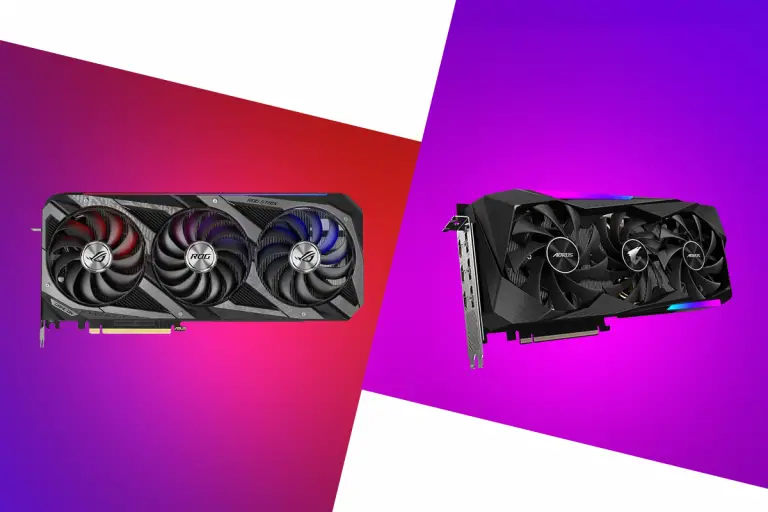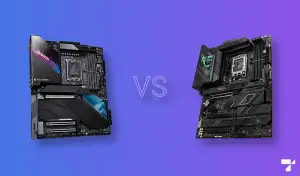Nvidia’s introduction of their Ampere series graphic cards has brought substantial performance gains over the previous generation Turing cards but at higher prices due to several factors. The RTX 3070 GPU is one of the best examples of this new generation’s capabilities. It manages to perform on par with the last-gen RTX 2080Ti flagship GPU in several games and applications. As a result, we have compiled this comprehensive review of the best RTX 3070 graphics cards.
The RTX 3070 also boasts of several new technologies introduced with the Ampere architecture. 2nd Gen RT Cores double the throughput, leading to better ray-tracing performance. A similar upgrade for the Tensor cores leads to an increased DLSS acceleration, responsible for boosting framerates and graphics. With HDMI 2.1 capability, this GPU can utilize supported monitors at 1440p and 4k at higher frame rates via a single cable.
With board partners releasing a slew of AIB RTX 3070 cards, it becomes increasingly challenging to select one that suits your needs, especially when it comes to spending more on cards that offer better overclocking and improved cooling for increased performance. Luckily, this handy guide will help you select the best RTX 3070 card for your PC.
 RTX 3070 Comparison Table
RTX 3070 Comparison Table
|
1
ASUS ROG Strix RTX 3070 OC
|
Features:
|
Specs:
|
Check Price |
|
2
EVGA GeForce RTX 3070 FTW3 ULTRA GAMING
|
Features:
|
Specs:
|
Check Price |
|
3
AORUS GeForce RTX 3070 MASTER
|
Features:
|
Specs:
|
Check Price |
|
4
GIGABYTE GeForce RTX 3070 Vision
|
Features:
|
Specs:
|
Check Price |
|
5
MSI RTX 3070 Gaming X Trio
|
Features:
|
Specs:
|
Check Price |
|
6
EVGA RTX 3070 XC3 Ultra
|
Features:
|
Specs:
|
Check Price |
|
7
ASUS Dual GeForce RTX 3070
|
Features:
|
Specs:
|
Check Price |
|
8
ZOTAC GAMING GeForce RTX 3070 Twin Edge
|
Features:
|
Specs:
|
Check Price |
Best RTX 3070 Graphics Cards
1. ASUS ROG Strix RTX 3070 OC
Specifications
Stream Processors: 5,888 | Base/Boost Clock: 1500 MHz/1755 MHz | Memory: 8 GB GDDR6X | Memory Clock: 14Gbps | Power Connectors: 2x PCIe 8-pin | Outputs: 2x HDMI 2.1, 3x DisplayPort 1.4aThe ROG Strix OC is Asus’s premium variant of the RTX 3070. It features a sturdy and well-built chassis, high-performance cooling system, and RGB lighting with AuraSync compatibility. As for raw power, the card features an OC Mode boost clock at 1935 MHz and a Gaming Mode boost clock of 1905 MHz which are quite impressive for RTX 3070 cards.
The cooling solution also seems to be pretty beefed up with the newly introduced Axial Fan design that includes extra fan blades and involves spinning the central fan in the opposite direction to increase the net air flow through the heatsink. The massive 2.9-inch slot design of the heatsink allows for a larger heat dissipation area, and the Max Contact heat spreader improves the transfer of heat between the GPU die and the heatsink.
The card’s passive cooling performance is good enough to let it run without the need for fans at idle and during lighter workloads, reducing noise and improving the fan lifespan. The card’s design also is now more muted with minimal RGB accents to help it better blend with numerous types of PC builds. The shorted PCB, coupled with the vented backplate, lets air flow through the card without having the chance to be recycled, further reducing the thermal load of the system.
Two 8-pin connectors are present on the top corner of the card, and with a 220W TDP, should not be a load on your existing PSU if it is at least 550W. The Dual-BIOS option on the card is great for loading up different profiles and can serve as a backup if something goes wrong. Also, the massive 2.9-slot design with a length of 31.9 cm would require a serious amount of space in your PC build. With several new features and better performance, the ASUS ROG Strix RTX 3070 OC should be your go-to choice if you have the extra money.
2. EVGA GeForce RTX 3070 FTW3 ULTRA GAMING
Specifications
Stream Processors: 5,888 | Base/Boost Clock: 1500 MHz/1815 MHz | Memory: 8 GB GDDR6X | Memory Clock: 14Gbps | Power Connectors: 2x PCIe 8-pin | Outputs: 2x HDMI 2.1, 3x DisplayPort 1.4aThe FTW3 Ultra RTX 3070 from EVGA improves performance over stock by increasing the power limit and implementing an advanced cooling system powered by EVGA’s iCX3 technology. With a boost clock increase of 90Hz, bringing it to 1,815 MHz from the stock 1,725 MHz, the card’s performance increase is enough to let it outperform the RTX 2080Ti by a comfortable margin.
The performance improvements are aided further by the extensive iCX3 cooling system that employs nine sensors providing real-time data of the card’s temperature levels. This data then helps independently regulate the speed of each fan. The center fan also has an offset of 10mm, increasing the airflow area by 16%. The GPU’s back metal plate features several cutouts to allow air to pass through, preventing hot air recirculation.
The heatsink also features some innovations like a set of perforations in the heat pipes to let air flow more easily through them. The copper heat spreader also is more extensive, allowing for better contact with the GPU die and VRAM modules. Even the metal backplate of the card features two heat pipes to help in additional heat dissipation. All these technologies work in tandem to keep the temperatures low and passively cool the card without fans’ need on idle or lighter workloads.
Overclockers will love the set of features included in this card, starting with the Precision X1 software, one of the best out there. It even includes data from the iCX3 sensors to help in making decisions. The Dual BIOS option is also essential to overclockers, serving as a backup if your system gets locked after being pushed to its limits. A PWM header for a fan for case fans is great for plugging in a case fan and is controlled by the card.
The card shares much resemblance to its RTX 3080 sibling save for a few color changes, like the white RGB strip on the top, which is addressable and can be controlled by your favorite software. With such numerous new features, this card is well worth the cost for enthusiasts who can get the best out of this card through overclocking thanks to the upgraded power solution and excellent cooling system.
3. GIGABYTE RTX 3070 8GB AORUS MASTER
Specifications
Stream Processors: 5,888 | Base/Boost Clock: 1500 MHz/1845 MHz | Memory: 8 GB GDDR6X | Memory Clock: 14Gbps | Power Connectors: 2x PCIe 8-pin | Outputs: 1x HDMI 2.1, 3x DisplayPort 1.4aGigabyte’s premium version of the RTX 3070 gives the card a slight performance boost while providing an excellent cooling solution, distinct design, and reliable build quality. The card’s 1,845 boost clock should tell you everything about its enhancements over the stock RTX 3070, which only manages to reach 1,725 MHz on boost, already making this one of the top performers on this list.
The new cooling system employed by Gigabyte is termed simply as Max Covered cooling. It features a stacked fan design where the fans overlap each other to improve the airflow’s uniformity. The central fan also spins in a direction opposite to the outer two, reducing turbulence and smoothening the airflow. A set of air-channeling Wind Claws under the fans also help direct the air toward the heatsink.
The heatsink itself is massive and features angular fins to increase the surface area for dissipation. The heat pipes directly connect to a large copper plate in contact with the GPU and the VRAM modules, allowing for a better heat transfer. The heatsink also extends beyond the PCB, letting the air through it and out from the metal backplate cutout, preventing hot air from recirculating.
The Aorus Master is also one of the best-looking cards with a well-designed shroud and even features a customizable LCD on the top edge. RGB on the card is also minimal and syncs with Gigabyte’s RGB Fusion 2.0 software. The sturdy metal backplate should also help keep your card from sagging when mounted. The 2.7-slot width and 29 cm length are a bit smaller than the other options on this list and should comfortably fit in most cases.
Performance on this card is pretty good considering the cooling and power delivery system is well capable of handling overclocking. The card’s Dual BIOS feature is also excellent for setting different profiles like performance and silent modes. The six display outputs on the back are also a win if you plan to use a multi-monitor system without the need for adaptors. The LEDs on the two PCIe, 8-pin power connectors are also great for troubleshooting connections.
Overall, the Arous Master RTX 3070 is an excellent card, considering its performance gains over the stock card. The outstanding cooling, considerable overclocking potential, extra display connectors, and beautiful design are good selling points if that’s what you are looking for and are well worth the card’s price premium.
4. GIGABYTE GeForce RTX 3070 Vision
Specifications
Stream Processors: 5,888 | Base/Boost Clock: 1500 MHz/1815 MHz | Memory: 8 GB GDDR6X | Memory Clock: 14Gbps | Power Connectors: 1x PCIe 6-pin, 1x PCIe 8-pin | Outputs: 2x HDMI 2.1, 2x DisplayPort 1.4aThe Gigabyte vision is a card aimed squarely at content creators and professionals, featuring a minimalistic design, free of the gamer-focused themes seen on most other graphic cards. The card also features a bumped-up boost clock of 1,815 MHz, 90 MHz over the stock clocks, giving a slight performance improvement.
The card employs Gigabyte’s Windforce cooling system, which, although not as powerful as the Max Covered cooling system from the Aorus Master, is well capable of cooling the card for creative workloads. The cooling system makes use of three 80 mm fans that employ alternate spinning for smoother airflow, direct heat pipe contact with the GPU die for better thermal transfer, and a heatsink design that extends beyond the PCB allowing for air to flow through it and out of the cutout in the metal backplate.
The GPU features one 8-pin and one 6-pin PCIe power connector and is the only card with this configuration in our list of RTX 3070 cards. The GPU comes in a clean white shroud with brushed aluminum accents throughout the card. The top of the card features a pink plastic strip with the Gigabyte logo that supports RGB and syncs with the company’s RGB Fusion 2.0. With a unique aesthetic, this card is an excellent choice for those putting together a PC with a clean design or content creators and professionals looking to use it at work.
5. MSI RTX 3070 Gaming X Trio
Specifications
Stream Processors: 5,888 | Base/Boost Clock: 1500 MHz/1830 MHz | Memory: 8 GB GDDR6X | Memory Clock: 14Gbps | Power Connectors: 2x PCIe 8-pin | Outputs: 1x HDMI 2.1, 3x DisplayPort 1.4aThe MSI Gaming X Trio is one of the most massive RTX 3070’s out there and makes the best use of its considerable heft to integrate a robust cooling solution and durable design. With a $59 price bump over the stock RTX 3070, the Gaming X Trio is one of the best cards out there for overclockers having the money to spend, thanks to the factory overclocking that raises the boost clock from 1,725 MHz to a sweet 1,830 Mhz. MSI achieves this overclock by upping the maximum power draw by 20W and using high-quality components in their PCB.
The Tri Frozr 2.0 thermal system features an all-new design updated to cool the 30-series cards more effectively. The Torx Fan 4.0 fan system features dual-linked fan blades to improve the airflow by channeling the air directly into the massive heatsink. Deflectors present in the heatsink increase the surface area and reduce the noise with unique fins. The six precision machined heat pipes contact the GPU die directly for a more efficient transfer of heat.
The card also comes with a fair amount of RGB accents, with a thin strip on the top of the card and a light-up MSI logo. The RGB syncs with MSI’s Mystic Light software. MSI Afterburner, a popular software for fine-tuning GPU clock speeds and power limits, supports this card natively and is a huge plus point for enthusiasts looking to overclock. The card is pretty hefty, coming in at 1441g and measuring 32.3 cm in length, so keep this in mind when choosing a case. The 240W TDP is low enough to let you use the card with an existing PSU, though you will need two PCIe 8-pin connectors.
The MSI Gaming X Trio is one of the best all-around overclocking options out there and is best for you if you are an enthusiast looking for pushing the RTX 3070 to its limits. MSI’s hardware and software options in this package are one of the card’s selling points.
6. EVGA RTX 3070 XC3 Ultra
Specifications
Stream Processors: 5,888 | Base/Boost Clock: 1500 MHz/1770 MHz | Memory: 8 GB GDDR6X | Memory Clock: 14Gbps | Power Connectors: 2x PCIe 8-pin | Outputs: 1x HDMI 2.1, 3x DisplayPort 1.4aThe XC3 Ultra costs lower than the FTW3 Ultra but still provides a performance level above stock, thanks to the iCX3 cooling solution found in the more premium EVGA cards and a factory overclock of 45 MHz to the boost clocks, bringing it to 1770 MHz.
The iCX3 solution on the XC3 Ultra is a more toned-down version of the one found in the FTW3 Ultra. The same fans cool the XC3 Ultra, though the sensors used to measure the temperature are fewer in number, making the asynchronous control of the fans much less accurate. The heatsink is identical to the technology the FTW3 uses, namely the porous heat pipes for better airflow and a more extensive copper base. The backplate also features multiple cutouts to enable hot air to pass through.
Those looking for a few performance gains can use the Precision X1 software to fine-tune the card. The card features RGB restricted to the EVGA logo and is an excellent choice for those looking for a less flashy build. The card is 2.2 slots wide and 28.5 cm long and should have no problems fitting into a majority of cases.
By cutting down on features usually required by enthusiasts, the XC3 Ultra is an excellent alternative to buy if you are looking for a midrange RTX 3070 that provides more than the usual features. Costing just $60 more, it’s a pick if you have the extra cash.
7. ASUS Dual GeForce RTX 3070
Specifications
Stream Processors: 5,888 | Base/Boost Clock: 1500 MHz/1755 MHz | Memory: 8 GB GDDR6X | Memory Clock: 14Gbps | Power Connectors: 2x PCIe 8-pin | Outputs: 2x HDMI 2.1, 3x DisplayPort 1.4aThe ASUS Dual RTX 3070 primarily aims to serve the general gamer population by sticking with a more traditional form-factor while still managing to improve the Founder’s Edition model’s cooling solution. The card also maintains the same boost clock speeds as stock, coming in at 1,725 MHz, though you might be able to get up to 1,755 MHz according to ASUS in the card’s OC mode.
Unlike other options, the card comes with only two fans, which use the company’s Axial-tech fan design with a smaller center, larger blades, and barrier ring in a bid to direct the airflow directly into the heatsink. An onboard controller also keeps the fans switched off when the card is at a temperature below 55 Celsius. The card also features a Dual BIOS option, allowing you to switch between performance and silent modes with the flick of a switch.
The card is well-built with a muted dark aesthetic and includes an aluminum backplate for rigidity and protection. RGB on the card finds itself concentrated around the ASUS logo on the top of the shroud. Although it still features a triple-slot design, the card does manage to come in at just 26.7 cm, perfect for most buyers’ existing cases, and with a 220W TDP, you may need to upgrade very little if you plan on buying this card.
With just a $30 price bump, the ASUS Dual RTX 3070 is the perfect card for most users, thanks to its compatibility and excellent build. If you were looking to squeeze the RTX 3070, this card would sadly not give you the best results due to its two-fan design and lower power limit.
8. ZOTAC GAMING GeForce RTX 3070 Twin Edge
Specifications
Stream Processors: 5,888 | Base/Boost Clock: 1500 MHz/1725 MHz | Memory: 8 GB GDDR6X | Memory Clock: 14Gbps | Power Connectors: 2x PCIe 8-pin | Outputs: 1x HDMI 2.1, 3x DisplayPort 1.4aThe Zotac Twin Edge RTX 3070 is perhaps the cheapest you can get for a custom RTX 3070 board. The card doesn’t skimp on performance with a dual-fan configuration, providing performance equivalent to the stock RTX 3070 GPU, with a boost clock speed of 1,725 MHz.
The card features Zotac’s Ice Storm 2.0 cooling solution with an 11-blade fan design providing an airflow improvement of 10% compared to previous generations. The card also features a direct contact heat pipe mechanism that draws heat more efficiently away from the GPU to the aluminum heatsink. The system’s passive cooling is enough to keep the fans idle at lower loads, reduce wear to the fans, and reduce system noise.
The card also includes the Fire Storm software for fine-tuning the clock speeds and controlling fans individually to cool only the areas that are at high temperatures. There is no RGB on this card, just a white light-up logo, and the aesthetic is Zotac’s angular design and grey color. The card’s best feature is its size with a small dual-slot width and 23.1 cm length, making it the best choice for small form factor builds featuring the RTX 3070.
If you were unable to get the Founder’s Edition RTX 3070, the Zotac Twin Edge RTX 3070 is your best bet for a custom board at the same price, though you may not be able to push the card via overclocking, primarily due to its smaller cooler.
Final Thoughts
The RTX 3070 is a good GPU for gamers looking to spend in the area of $500 to $700 for a graphics card. Although with the release of AMD’s RDNA2 cards, there is stiff competition from the RX 6800. It is important that you make sure to search multiple GPU vendors before deciding to purchase a specific RTX 3070 model as prices can vary greatly. We hope that this article will help you make an informed RTX 3070 decision.



